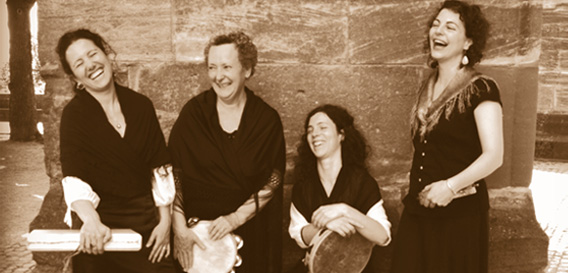
CANTADERAS is the name of a women’s ensemble with a solid musical education in the field of early music, allowing the combination of musical repertoires from the 13th to the 16th centuries (Gregorian chant, Cantigas de St. María, Notre Dame School, early and renaissance polyphonies, …) with other repertoires coming from oral traditional music, mostly performed by women.
Anne Marie Lablaude, Ana Arnaz, June Telletxea and Paloma Gutiérrez del Arroyo approach this women’s repertoire, relying on the experience as early music singers.
More information on cantaderas.anaarnaz.com
Musicians websites: palomagutierrezdelarroyo.com
PROGRAMS
READING HEAVEN’S BOOK. Survival of the community
Cantaderas bring to life some of the remains of the close relationship between humans and the atmospheric elements with two different repertoires, connecting medieval Gregorian chant and the traditional Spanish music from the beginning of the 20th century. The stars and the cardinal points, winds and clouds will be revealed throughout this program, in the religious texts as well as secular, coming from the most ancient written tradition (Responsorys, Antiphons and Tracts) as well as from the most perennial oral tradition (songs greeting the dawn, rogations songs asking for the rain, serenades, wedding songs). Read more…
AS FESTAS DO ANNO. Nature and religion in one thread
« This song is for the pilgrimage which takes place during the Assumption’s Day» is the title of the Cantiga de Santa María n° 420, and it is easy to imagine that it was composed for a pilgrimage like El Ramo a la Magdalena, performed by women in Asturias. For the program As Festas do Anno, the Ensemble Cantaderas has chosen to focus on the last Cantigas de Santa María del Códice Princeps de El Escorial, written and sung at festivals and holy days throughout the year: the Epiphany, the Annunciation, the Ascension, the Assumption and the Festival of the Crosses held in May. Read more…
CATHARSIS. About death and life
Cantaderas proposed program gives shape to one of the most important periods of the liturgical year: Easter time. Its importance is due to a repeating transformation: sorrow turns into happiness; grief into hope and sadness is replaced by joy. Catharsis highlights this transformation with a repertoire that transports the listener from the image of pain to joy: from lent to Easter Sunday, from winter to spring. The medieval repertoire chosen from the Florence Manuscript (the most important source from the Notre Dame repertoire) are the Rondelli sung during Easter time.Read more….
DEVOTA FECUNDITAS. When God was a woman
Friday morning. A group of women knock on the door of every village house to ask for grain. They will bring it to the mill, and with that flour they will bake the bread and the cakes, which will be offered to the saint on the Sunday procession. The men observe while women of all ages perform rituals, singing and playing. Accompanying themselves on hand percussion … Read more…
